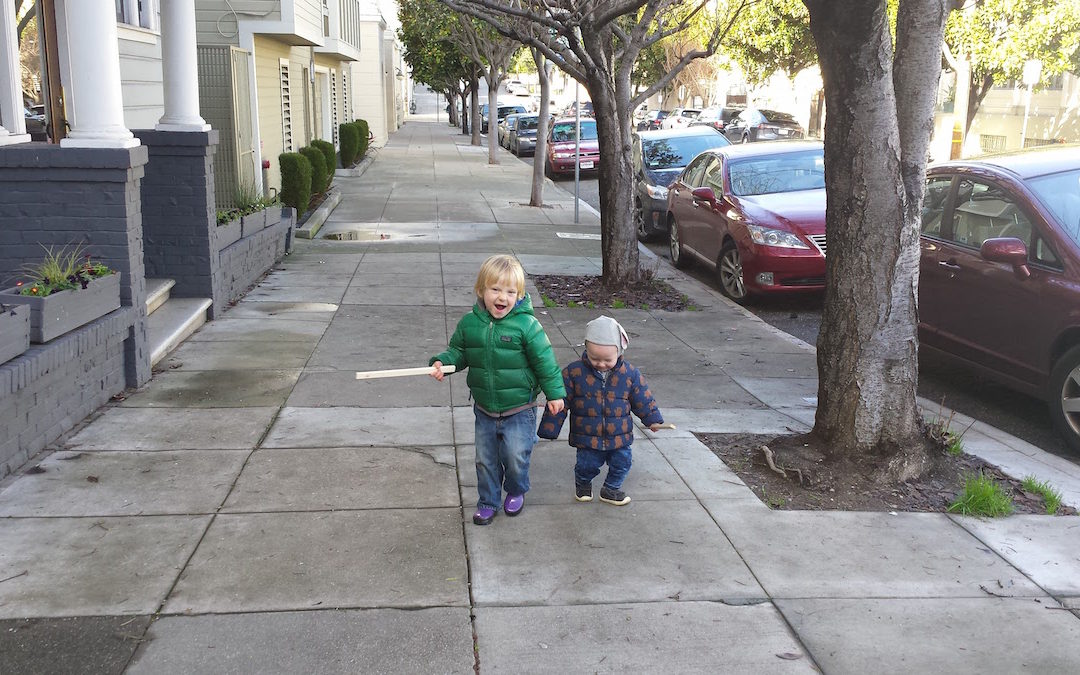If you’ve ever walked with a toddler, you know how difficult it can be to get from one place to another. Go a couple steps, notice a bump of gum on a brick… Stop to examine it. Go a couple more steps… Spy a shiny gum wrapper. Stop to pick it up. Go another step, hear a dog tag jingle behind you, turn back around and start walking the other way… You get the picture!
As beautiful as it is to watch our little ones explore, there are times when we need to move a little faster than the speed of toddler. This is another one of those times when a song can be really helpful. Instead of calling, cajoling or carrying them off shouting, try this, instead… Start in the direction of where you need your child to go, and sing a song to help draw her attention to what you’re doing. You’ll often find this works like a charm. At least until the next gum wrapper!
At the end of this post, I’ll share a few songs to help you get from point A to point B a little more efficiently. But first, I want to talk a little about toddler development, to help you understand what makes songs so effective as a parenting tool.
Some Background — Learning through Imitation
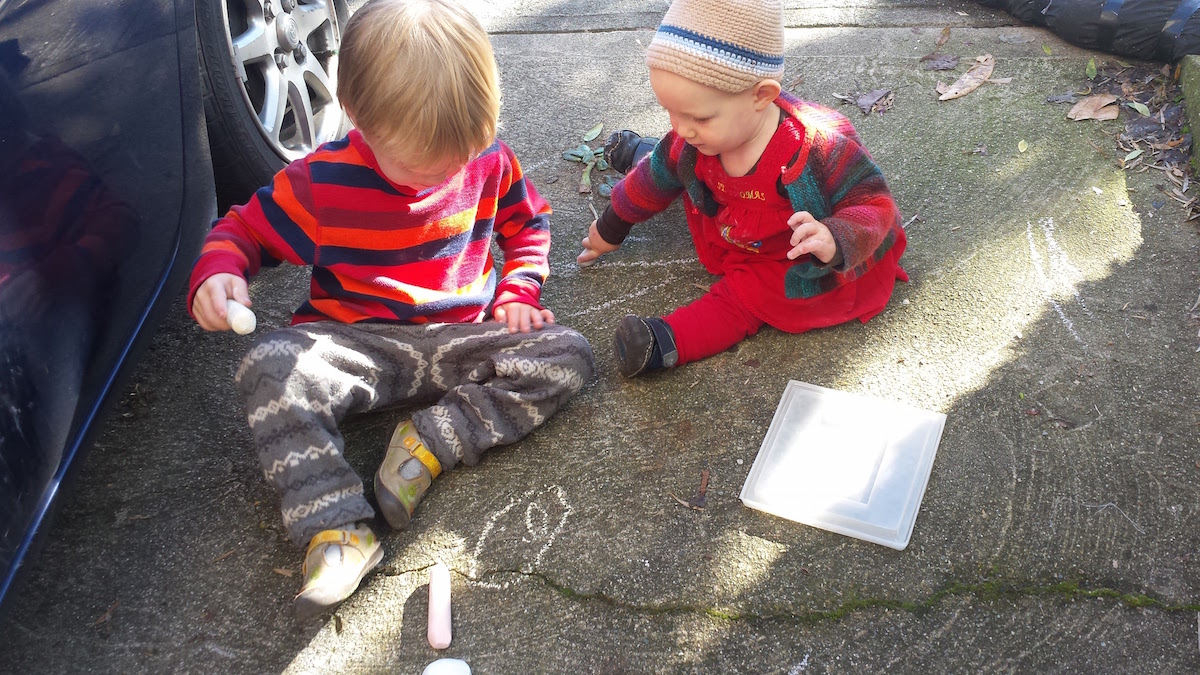
Imitation in action, as demonstrated by my own two children. This was also the first time my son drew a face.
Young children learn through imitation. This is one of the most important insights of Waldorf early childhood education. But you don’t have to know anything about Waldorf education to appreciate this. If you’ve spent time with a little one, you’ve seen it in action.
Young children imitate everything, even things we do not commonly pay attention to as adults. One morning, I noticed my one year old making a peculiar noise in her high chair. I stopped my snack prep to listen, and could now hear that she was imitating a large crow in the tree outside. Busy with my housework, I hadn’t even noticed the bird. But my daughter was acutely attuned to it, and was already happily speaking in crow, imitating the precise cadence of each call.
Our young children don’t only imitate living things. They imitate inanimate objects as well. My four year old is fascinated by vacuums. There was a period of a year when basically anything he held, he would pick it up and vacuum with it, while making a machine hum sound. Kitchen implements, sticks at the park, stuffed animals, you name it. The world was his vacuum.
The urge to imitate is especially strong between siblings. Yesterday I watched my daughter, now nineteen months old, pick up one my son’s stuffed animals, a brightly colored turtle. She began to move the turtle over the floor, saying “Bszhhhhhhh.” For a moment, I looked on, puzzled. Then I realized what she was doing, and I started to laugh. Of course, she was vacuuming with it. She’s learned well from her brother– that’s what turtles are for.
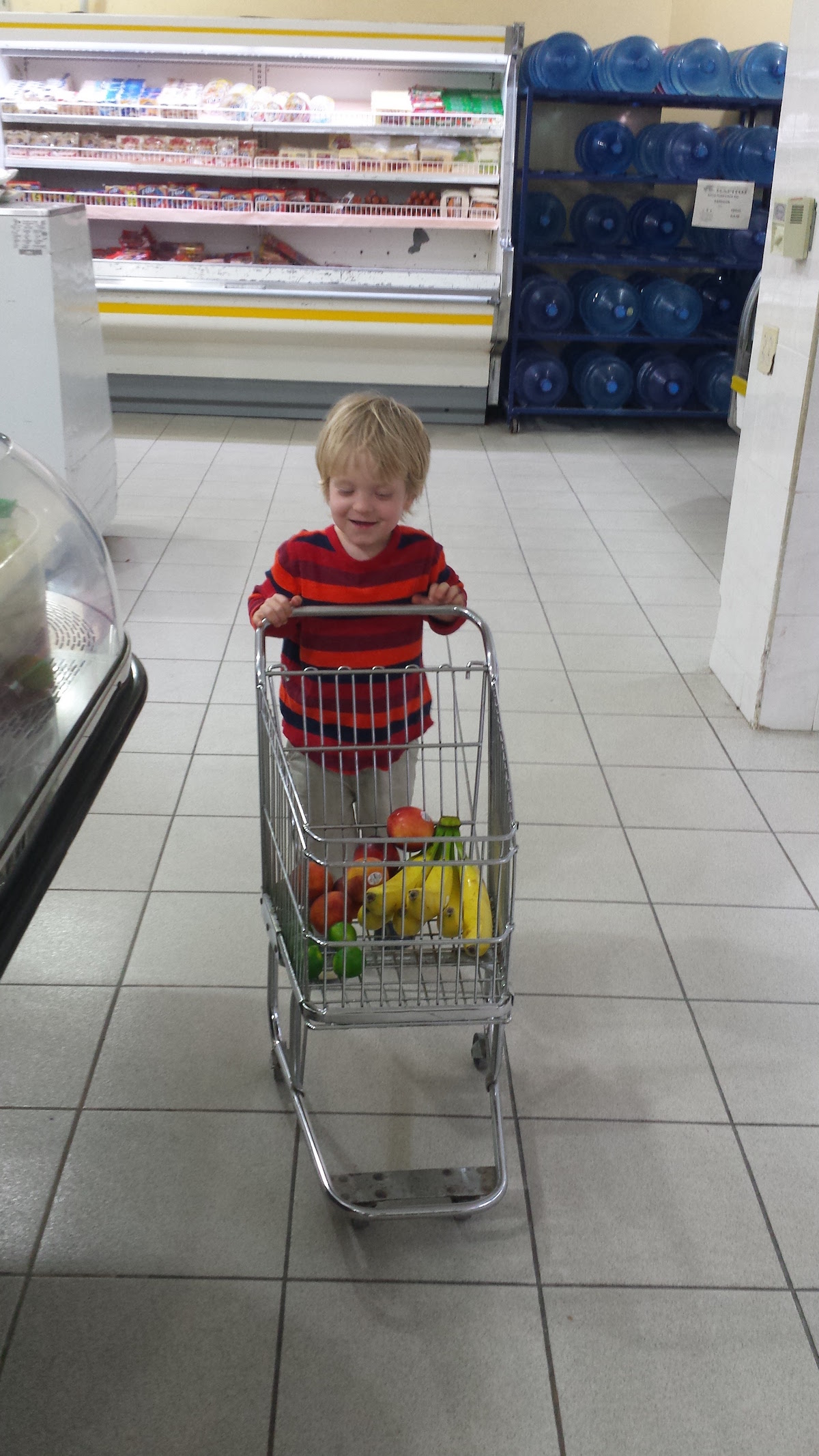
This Mexican grocery store was well equipped to help children learn through imitation. They had miniature shopping carts so that toddlers could shop alongside their parents.
The idea that children learn by imitation seems simple at first glance, but this has profound implications for how we can best guide them. Think about it… what’s your go to method when you need to get your child’s attention? For most of us, the first instinct is to give a verbal directive. Now, it makes sense that speech is our go to, for in the world of adult interactions, words are often our best means of communicating.
But have you noticed that with young children, verbal directives can be frustratingly ineffective? Do you ever find yourself repeating a direction multiple times, to no avail? Have you ever gotten so frustrated that you hear yourself saying, “You’re not listening! I need you to listen!”
Have you ever wondered in frustration, why don’t young children listen? (By which we usually mean, why don’t they do what we say!)
There are a lot of reasons why children may not do what we ask. But for the purpose of this post, I want to just focus on one– young children are simply not wired to respond best to verbal direction. They learn through doing, and they develop their understanding of what to do through imitating you and others. The surest way to get your young child involved in something? Start doing the thing you’d like them to be doing with no more words than necessary. When necessary, offer additional guidance through gentle touch, brief, warm words, or a song. You’ll be amazed at how much easier it can be to get your child on board with things, when you try this simple method.
Insights from a Waldorf Kindergarten
The first time I really felt what this looks like was about eight years ago, before the birth of my own children, when I took a job assisting in a Waldorf kindergarten. The first day I observed in the classroom, I was astonished. This early childhood environment was unlike any I’d seen. Twelve children buzzed about, busy with play and work of their own choosing.
Two were helping the assistant teacher chop vegetables for soup time. Another was building a block tower taller than he was. Three girls snuggled in a loft, pouring over a picture book. A teacher sat in a rocking chair, quietly humming to a little one on her lap.
What made this classroom so unusual? Well, yes, there were those beautiful natural toys. There were soft colors and sheep skins, and sweet china dishes, and organic food, and all those things that Waldorf is famous for. But it was more than this. What was it? For a while, I couldn’t put my finger on it. Then I realized what it was– the adults never raised their voices! When it was necessary to redirect a child, they did it through touch, gesture, or song.
And the songs… The songs weren’t like anything I’d heard before in an early childhood setting. They weren’t big, get-your-attention numbers that got feet stamping and hands clapping, like so much music for children aims to do. They weren’t particularly entertaining, in fact. Instead, the songs were peaceful– almost subliminal. Like fragments of an overheard conversation, they created a mood, and guided the children gently, subtly, and only where guidance was needed. I thought this classroom was like an ashram, if ashrams focused on work like dressing dolls, grinding grain, and creating marvelous tea parties.
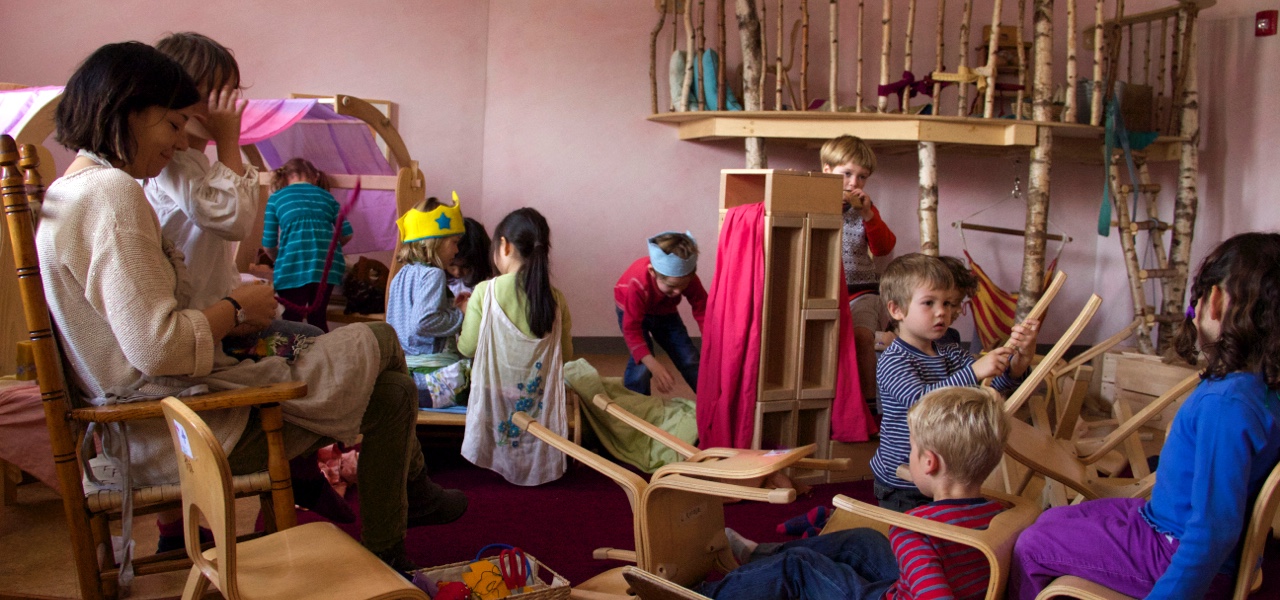
Classroom at the Brooklyn Waldorf school, where I first experienced Waldorf early childhood education.
Needless to say, I was hooked, and I have been, to varying degrees, involved with Waldorf ever since.
To access the powers of touch, gesture, and song to help guide children takes work, especially in our culture, which is so heavily speech centered. For Waldorf early childhood teachers, the work is ongoing. But once we start doing it, we notice every day how much more effective it can be, modeling for children and lovingly bringing them along with us, versus telling them what to do.
Here’s an example from my son’s Waldorf inspired nursery school, Golden Bridges. One of my son’s teachers is heavily pregnant. In keeping with the understanding I’ve described above, she has embraced the inner work of guiding the children with as little speech as possible. This means that when a child is needs redirecting, she does so with touch, song, or just a few words- no more than necessary. At our last parent meeting, she described how as she’s gotten bigger, she’s more sedentary, and as a result finds herself relying more on her voice than she has in the past. What has she learned?
“Now that I’m talking more, I can see the relationship so clearly,” she explained. “The more I talk, the less they listen.”
This was a bittersweet revelation for a heavily pregnant mama to be who just wants to put her feet up!
Two Songs for Moving Little Ones Along
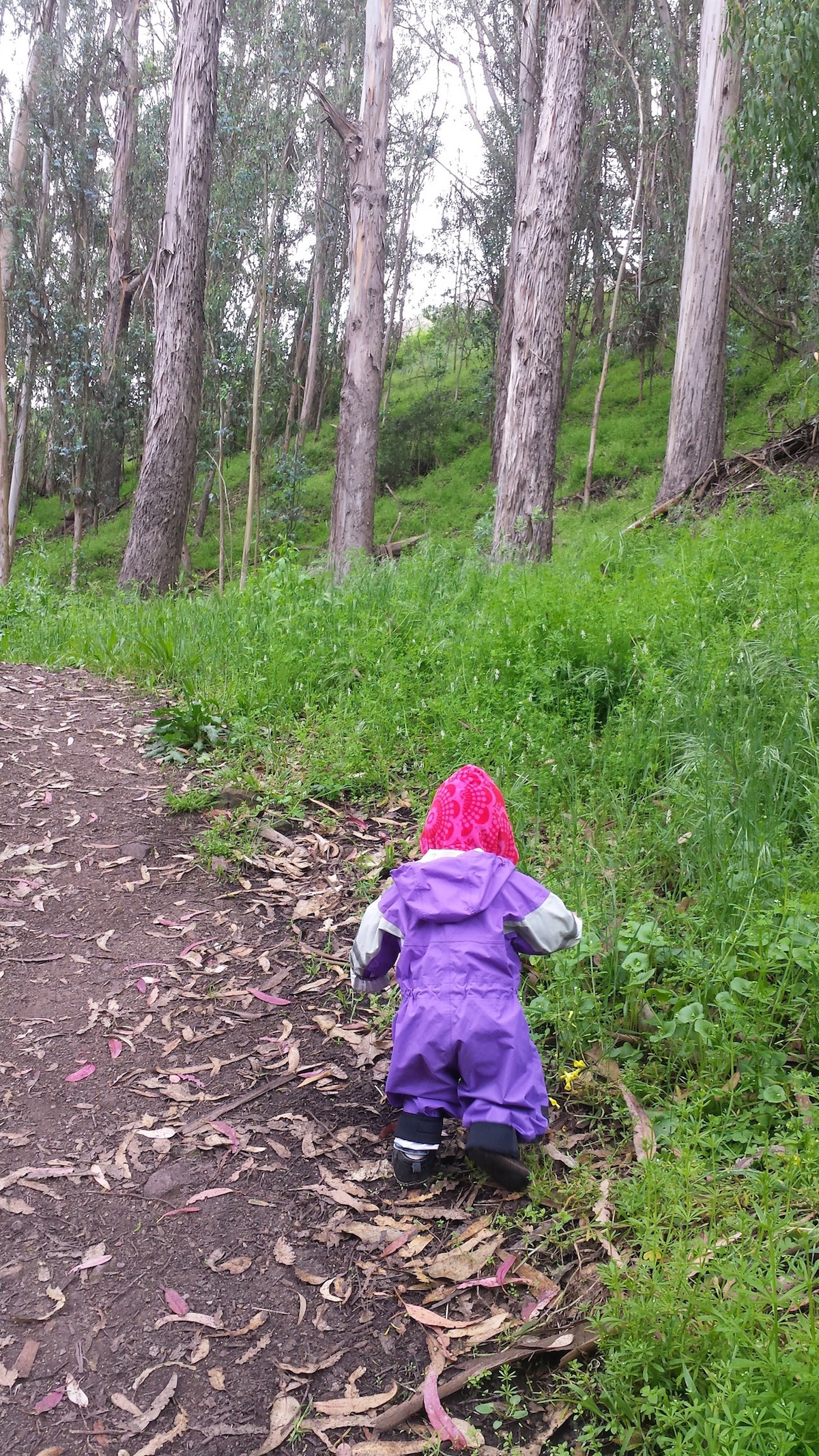
Peregrine scales a hill in Glen Canyon. What you can’t hear is that she’s singing “Come Follow Me” as she does it!
So try this… The next time you need to get your child to do something, instead of talking, try modeling the behavior you want to see, and use gentle touch if necessary. And as you do this… sing! You’ll be amazed how good it feels to engage with your child in this way. And with any luck, you may even find you can get down a city block in less than an hour. 🙂
So, without further ado, here are some songs to move your little ones along.
Come Follow Me
Come, follow, follow, follow
Follow, follow, follow me
Wither shall I follow, follow, follow?
Wither shall I follow, follow thee?
To the greenwood, to the greenwood
To the greenwood, greenwood tree
Jim Along Josie
Hey, Jim along Jim along Josie
Hey, Jim along Jim along Joe
Repeat, replacing “Jim along” with whatever feels right to do.
Walk along, jump along, hop along, dance along, skip along… Whatever you like!
And here’s one last useful song – this one is great for folding laundry, putting things away, or whatever chores around your house need doing.
If you enjoyed this post, here are a few ways to go deeper:
Wherever you live, you can download our latest album. It’s free / pay what you want!
You can also join the conversation via our online community, Deep River Families.
And.. If you’re in the SF Bay Area, we warmly invite you to join us in person!
Meadowlark Music Class, my weekly music class for children and caregivers, meets W, TH, and F mornings at indoor and outdoor locations around San Francisco.
My outdoor Waldorf parent child class, Apple Star, meets Tuesday mornings in Glen Canyon.
And Mothersong Chorus, my women’s singing circle, meets Sunday afternoons at Community Well.

